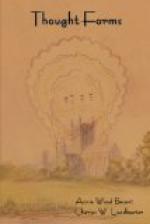Three general principles underlie the production of all thought-forms:—
1. Quality of thought determines colour.
2. Nature of thought determines form.
3. Definiteness of thought determines clearness of outline.
THE MEANING OF THE COLOURS
The table of colours given in the frontispiece has already been thoroughly described in the book Man Visible and Invisible, and the meaning to be attached to them is just the same in the thought-form as in the body out of which it is evolved. For the sake of those who have not at hand the full description given in the book just mentioned, it will be well to state that black means hatred and malice. Red, of all shades from lurid brick-red to brilliant scarlet, indicates anger; brutal anger will show as flashes of lurid red from dark brown clouds, while the anger of “noble indignation” is a vivid scarlet, by no means unbeautiful, though it gives an unpleasant thrill; a particularly dark and unpleasant red, almost exactly the colour called dragon’s blood, shows animal passion and sensual desire of various kinds. Clear brown (almost burnt sienna) shows avarice; hard dull brown-grey is a sign of selfishness—a colour which is indeed painfully common; deep heavy grey signifies depression, while a livid pale grey is associated with fear; grey-green is a signal of deceit, while brownish-green (usually flecked with points and flashes of scarlet) betokens jealousy. Green seems always to denote adaptability; in the lowest case, when mingled with selfishness, this adaptability becomes deceit; at a later stage, when the colour becomes purer, it means rather the wish to be all things to all men, even though it may be chiefly for the sake of becoming popular and bearing a good reputation with them; in its still higher, more delicate and more luminous aspect, it shows the divine power of sympathy. Affection expresses itself in all shades of crimson and rose; a full clear carmine means a strong healthy affection of normal type; if stained heavily with brown-grey, a selfish and grasping feeling is indicated, while pure pale rose marks that absolutely unselfish love which is possible only to high natures; it passes from the dull crimson of animal love to the most exquisite shades of delicate rose, like the early flushes of the dawning, as the love becomes purified from all selfish elements, and flows out in wider and wider circles of generous impersonal tenderness and compassion to all who are in need. With a touch of the blue of devotion in it, this may express a strong realisation of the universal brotherhood of humanity. Deep orange imports pride or ambition, and the various shades of yellow denote intellect or intellectual gratification, dull yellow ochre implying the direction of such faculty to selfish purposes, while clear gamboge shows a distinctly higher type, and pale luminous primrose yellow is a sign of the




